Abstract
Vasa (Adhatoda vasica Linn.) is a well known and easily available drug in almost all the seasons. Easy availability of any drug gains popularity among physicians as well as pharmaceuticals and this is the reason why almost every Kalpana of Vasa is found described in the Ayurvedika text. The different dosage forms of Vasa like Kvatha, Avaleha, Sneha, and Sandhana have been used for the treatment of Shwasa Roga. A number of research studies have been performed on different formulations of Vasa and its effect on Shwasa Roga. Therefore, a review study has been carried out on the Vasa extract, Vasa Avaleha (prepared from Svarasa and Kvatha), Vasa Ghrita, Vasarishta, and Vasakasava on Shwasa Roga, to know which formulation is better. It was found in the review that Vasa Ghana, Vasa Ghrita (1), and Vasa Avaleha have shown good results on Tamaka Shwasa.
Keywords: Ghana (extract), Avaleha, Shwasa, Asava, Arishta, Tamaka Shwasa, Adhatoda vasica
Introduction
Acharya Charaka says that an ideal drug should be available throughout the year, that is, Bahuta, and it should be capable of converting into different dosages forms, that is, Anekavidha Kalpana[1] without altering its pharmacological actions. However, it is not feasible as it is often seen that the plants, in the peak of their active principles, are not available at all times and so it is necessary to collect them in a specific season.[2] Therefore, it is also essential to convert these plants into some formulation without them losing their potency, so that they may be available to us in their original potency throughout the year. Extract (Ghana),[3] Avaleha,[3] Sneha,[4] Sandhana[5] and Kalpana are the modified forms of Panchavidha Kashaya Kalpana, which make the drug material available throughout the year, help in a long shelf-life,[6] help in good taste, an elegant look, pleasant smell, and produce quick action with low doses. Despite this, Sneha, Sandhana, and Avaleha Kalpana have their own specific qualities, namely, Sneha pacifies the Vata Dosha,[7] has the capacity to reach each and every Srota to simulate Dhatu, while Sandhana produces quick action, palatability, ability to reach each and every Srota, and has the capacity to remove the obstruction; this marks their utility in different diseases or different stages of the disease. Ghrita Kalpana is one that is predominately used for oral use, while Asava Arishta is popular among the Sandhana formulations. Therefore, it is mandatory to specify the use of this Kalpana in the diseased condition. Avaleha is one of the most popular Kalpanas, due to its dosage form, which helps in easy administration, palatability, and long shelf-life. It has been widely used as a rejuvenator (Rasayana) by Acharya Charaka, Sushruta, and Vagbhatta, except for diseases like Kasa, Shwasa, Shotha, and so on. Avaleha is used very often.[8] although Ghana is a synonym for Avaleha, but mostly it is devoid of sugar, honey, and Ghrita. This is also not in routine use in the Samhita period unlike Avaleha, Sneha, and Sandhana. Therefore, it is mandatory to specify the use of these Kalpanas in the diseased condition, as Acharya Charaka states that every Kalpana is not useful for each person having the same disease.
Vasa is a drug that draws attention because of its use in different Kalpanas and almost every Kalpana [Table 1] of this drug is available in a classic recapitulation of ancient literature that draws attention with regard to the utility of Vasa in a different formulation. The same is summed up in the form of Bhisakamata[9] as a synonym of Vasa.
Table 1.
Various dosage forms of Vasa described in different classics

The Shwasa is a pathological condition in which Prana Vayu gets vitiated by itself or others, which leads to the upward movement of the Prana Vayu, hampering its normal functioning.[10] Asthma is a chronic inflammatory disorder of the airways in which many cells and cellular elements play a role. The chronic inflammation is associated with airway hyper-responsiveness that leads to recurrent episodes of wheezing, breathlessness, chest tightness, and coughing, particularly at night or early in the morning. These episodes are usually associated with widespread, but variable airflow obstruction within the lung that is often reversible either spontaneously or with treatment of the total global disease burden. Asthma is a problem worldwide, with an estimated 300 million affected individuals, along with 250 000 deaths estimated worldwide annually.[11]
A great number of research studies on Vasa have been carried out on different aspects.[12–16] Many studies related to its different Kalpana-like extract (Ghana), Avaleha, Sneha, and Sandhana Kalpana have also been reported. Although all these formulations have good results on Shwasa, there is no report on which of these is better. So, with this objective, a review was carried out to know the better one. The studies that have been taken for review, which were done mainly in the Department of Rasashastra and Bhaishajya Kalpana, Institute for Post Graduate Teaching and Research in Ayurveda, Gujarat Ayurved University, are as follows:
Prasher Ramnivas et al., Standardization of Vasa Ghrita and its extract form and their comparative pharmacoclinical study, with special reference to Shwasa Roga, Jamnagar, 1997.
Kulkarni Shailaja et al., A comparative and pharmacoclinical study of Vasarishta and Vasakasava in the management of Shwasa, Jamnagar, 2001.
Gandhi Piyush et al., A comparative study of different formulations of Vasa (Avaleha, Sneha, Sandhana) with reference to to its Shwashara effect, Jamnagar, 2005.
Gupta Ankit et al., A comparative pharmaceuticoclinical study of Vasa Avaleha prepared from Swarasa and Kwatha with reference to its Shwashara effect, Jamnagar, 2006.
Materials and Methods
Preparation of test drugs
Dry Vasa extract (Ghana) was prepared using the principles of Raskriya.[3] The double-filtered Kwatha of Vasa was put on moderate heat, with constant stirring, till the formation of Ghana. A fine powder of Vasa Pushpa was added at the stage when it gains semi-solid consistency suitable for pill making and mixed properly. Vasakasava and Vasarishta[17] were prepared using Vasa Swarasa as the liquid media, 35% of Guda and Prakshepa were added initially and the remaining quantity of Guda was added after starting the process of fermentation. Vasa Ghrita (1)[18] was manufactured from the ingredients Vasa Kwatha, Ghrita, Vasa Pushpa Kalka, and honey, whereas, Vasa Ghrita (2) was prepared by Vasa Kwatha, Ghrita, and Pippali, as Kalka and the Paka were done till the Sneha Siddhi Lakshana appeared. Vasa Avaleha[19] was prepared by adding Guda and Ghrita to the Vasa Swarasa / Kwatha and Paka was done till the Avaleha Siddhi Lakshana appeared; then Pippali powder was added to it and mixed well. Honey was added after cooling.
Selection of patients
Patients attending O.P.D and I.P.D. of the R.S. and B.K. Department of IPGT and RA Hospital, fulfilling the criteria of diagnosis of Tamak Shwasa were selected and registered randomly, irrespective of age, sex, or religion.
Criteria for diagnosis
Patients having signs and symptoms of Tamak Shwasa as described in Ayurvedic classics, namely, Shwasakashtata, Kasa, Pinasa, Kanthodhvansa, Lalatesweda, and Asinolabhetesukham, were selected for the present study. Detailed history was taken and physical examination was completed on the basis of a special proforma, incorporating the signs and symptoms of the disease.
Investigations
Routine hematological, especially white blood cell (WBC), erythrocyte sedimentation rate (ESR), AEC and urine, and stool examination were carried out in all the patients, to assess the condition of the disease and to exclude any other pathology. Biochemical investigations like BSL (F), Lipid profile, and Sr. Bilirubin were carried out to exclude any other pathology.
Diet and restriction
Patients were advised to avoid the aggravating factors mentioned in ancient literature.
Dose and duration
Two grams of the Vasa extract (Ghana) was given, while the dose of Vasa Ghrita (1), Vasa Ghrita (2), Vasa Avaleha (s), and Vasa Avaleha (k) was 10 g; however, for the Vasakasava and Vasarishta it was 20 mL. All the drugs were given b.i.d. with water, for 21 days, except Vasa Avaleha (s) and Vasa Avaleha (k), which were given for 28 days.
Criteria for assessment
The efficacy of the trial drugs was analyzed in terms of the relief produced in the signs and symptoms before and after treatment. To assess the relief, the scholars had prepared a proforma with a grading system ranging from 0 to 3 [Table 2]. The effect of the trial drugs were also analyzed on certain parameters like WBC count, AEC, and ESR, before and after treatment.
Table 2.
Gradation / scoring of the signs and symptoms pattern for Shwasa

Results
Highly significant (P < 0.001) results on Shwasakashtata were found in all the test drug groups except in Vasa Ghrita (2), which was only significant (P < 0.05) [Table 3]. The effect on Kasa was also highly significant (P < 0.001) in all groups, whereas, it was insignificant (> 0.10) in the Vasa Ghrita (2) group [Table 4]. The effect on Pinasa was highly significant (P < 0.001) only in Vasa extract (Ghana)-, Vasa Ghrita (1), Vasa Avaleha (s)-, and Vasa Avaleha (k)-treated groups [Table 5].
Table 3.
Effect of drugs on Shwaskashtata
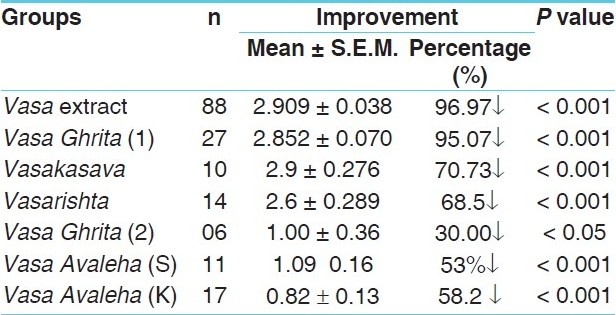
Table 4.
Effect of drugs on Kasa
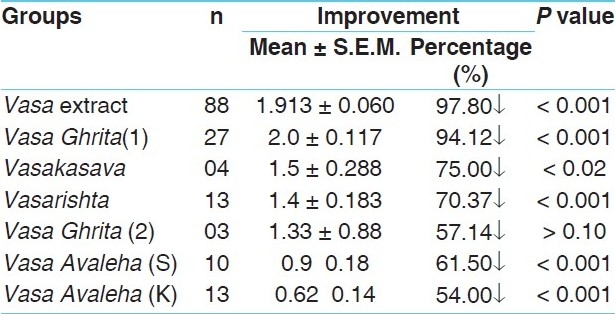
Table 5.
Effect of drugs on Pinasa
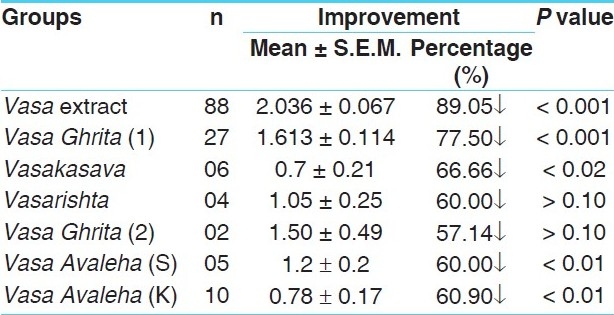
The Vasa extract (Ghana), Vasa Ghrita (1), Vasakasava, Vasarishta, and Vasa Avaleha (k) have shown highly significant (< 0.01) results on Kanthodhvansa, while Vasa Avaleha (s) has shown a significant (< 0.05) result [Table 6]. The Vasa extract (Ghana), Vasa Ghrita (1), and Vasarishta have shown a highly significant (< 0.001) result on Lalatesweda, while Vasa Avaleha (s) and Vasa Avaleha (k) have shown a significant (< 0.05) result [Table 7]. Highly significant (P < 0.001) results on Asinolabhetesukham were found in Vasarishta-, Vasa Avaleha (s)-, and Vasa Avaleha (k)-treated groups, while in the Vasa Ghrita (2), the result was insignificant (P < 0.02) [Table 8]. Highly significant (P < 0.001) results on wheezing were found in all the test drug groups except in Vasa Ghrita (2), which was insignificant (P < 0.02) [Table 9]. No statistically significant result on hematological parameters was observed in any of the treated groups except by the Vasa extract (Ghana), in which a highly significant (P < 0.001) decrease was seen on eosinophil.
Table 6.
Effect of drugs on Kanthodwamsa
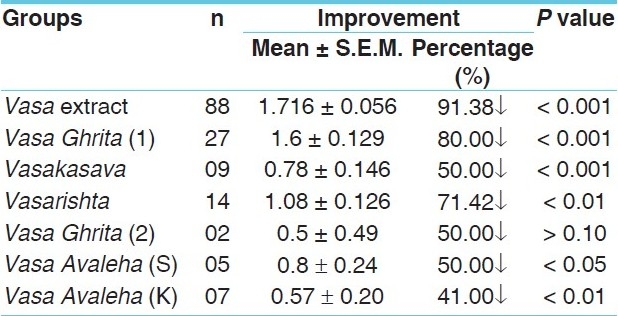
Table 7.
Effect of drugs on Lalatesweda
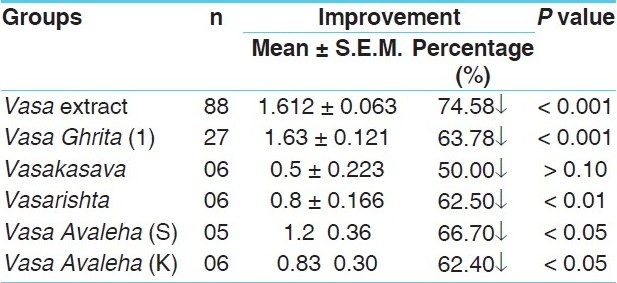
Table 8.
Effect of drugs on Aasinolabhetesukham
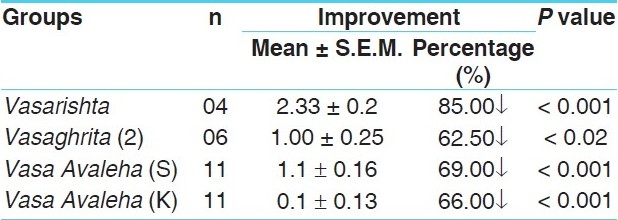
Table 9.
Effect of drugs on wheezing
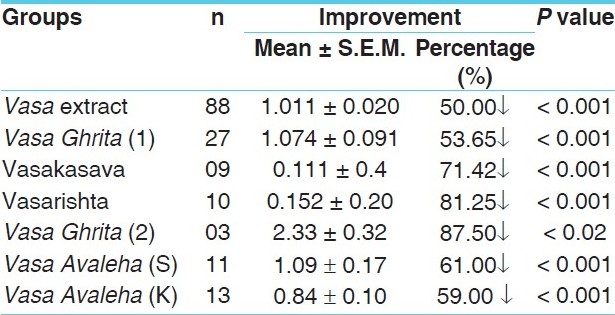
Discussion
The development of different dosage forms mainly depends on two factors. The first one belongs to the physician concerned and includes the immune response of the patient and severity of the disease (Atura and Vyadhi Bala).[20] The second one covers the pharmaceutical concern like palatability, dose accuracy, long shelf-life, bioavailability, and so on.
Licking of Avaleha generally on upper part of tongue enhances salivation due to its sweetness. Excessive salivation causes trigging of the mixture over the naso-oropharynx and larynx, which ultimately produces a soothing effect in the throat, relieving irritation. Secondly, these solutions expose the drug material to the mucosa, which may produce the local effect of the drug.
Sneha preparation is one of the distinctive formulations of Ayurveda. Sneha Kalpana (oleaginous medicament) is the hallmark of the pharmaceutics of Ayurveda, which is used in all routes of administration.[21] Contemplation of the ancient literature reveals that the Ghrita and Taila are predominately used for internal and external application, respectively. Along with the qualities of Substratum-Kwatha and Swarasa, it also possesses Sukshma, Ushna, Tikta, Vikasi, and Pramathi properties.
The ancient scholars were specialists enough to utilize each and every bio-substance [plant–animals], metal, and mineral, and every process in the nature was observed for the benefit of the human beings. The best example of this is Sandhana Kalpana. Madya — a type of Sandhana Kalpana, which generates alcohol, has a good preservative value, and Vyavayi and Asukari properties. These properties of Madya contribute to its quick action and target site delivery of the active principle. Among the Madya Kalpana, Asava and Arishta are extensively used in day-to-day practice, due to their low-alcohol content.
Comparison of all the formulations [Table 10] shows that Vasa Swarasa / Kwatha (as it contains alkaloid like vasicine and vasicinone are proven bronchodilators)[22] is common among all. Vasa Pushpa is further added to the Vasa extract (Ghana), which is a consolidated form of the double-filtered Kwatha of Vasa, before converting it into the Vati form; this is definitely going to enhance the potency of the formulation, which may be the reason for good clinical results. There was a drawback regarding the dose fixation of this formulation, as described by scholar Prasher et al., where initially an equivalent dose, that is, 7.2 g of the Vasa extract (Ghana) per day was given, but this produced some undesired effect like increase in dyspnea after 4–5 days of treatment. In one or two patients, the dose was reduced to 4 g daily, in two divided dose. Vasa Ghrita (1) has shown good results, as Ghrita has its own quality to pacify the Vata and Pitta[23] and exhibits the Brinhana property needed for the treatment of Shwasa[24] and various types of Ghrita. Besides this, the Vasa Ghrita[25] is also used to deal with Shwasa. The reason for the not-so-good results in the Vasa Ghrita (2)-treated patients may be counted, as it has low-sample size as well as some alteration in the original reference. Vasakasava and Vasarishta have shown highly significant results on symptoms like Shwasa Kashtata, Kanthodhvansa, and Asinolabhetesukham, where as in some of the symptoms like Peenasa, Vasakasava has shown better results while Vasarishta proved better in Kasa and Lalatesweda. Vasa Avaleha either prepared from Swarasa or Kwatha have shown consistent results for most of the symptoms. The possible reason for this may be because it contains Guna, Ghrita, and honey along with Vasa and Pippali. Here, honey gives a soothing effect, whereas, Ghrita pacifies the Vata and Pitta. Another reason for this is also supported by Acharya Charaka where he states that Brimhana Chikitsa is excellent for treating the Shwasa.[24] This may be fulfilled by Avaleha as it contains Guda, Ghrita, and honey.
Table 10.
Details of the ingredients in the test drugs

In spite of Rogi and Roga Bala the other factors like Kala (season) and palatability of dosage form (because some persons are Snehadweshi)[26] must be kept in mind while treating any disease. All these studies are also completed within a certain time limit. Therefore, all these factors may be responsible for the variation in the results.
Conclusion
From the study it is concluded that different formulations of Vasa have been used for the treatment of Shwasa, since the period of Acharya Charaka and Sushruta. Here in this study, all the formulations have shown good results, but the Vasa extract (Ghana), Vasa Ghrita (1), and Vasa Avaleha (Swarasa/ Kwatha) are more consistent.
Acknowledgments
The authors acknowledge the Director I. P. G. T. and R. A. and I/c Vice-Chancellor Gujarat Ayurved University, Jamnagar, Prof. M. S. Baghel, for giving the permission to review these research studies for the benefit of a future planner. The authors also acknowledge all the scholars, supervisors, and co-supervisor of the research study, who have directly or indirectly helped in the publishing of these findings.
References
- 1.Jadavaji T, editor. Sutrasthan. 5th ed. Varanasi: Chaukhambha Sanskrit Sansthan; 2001. Charaka Samhita. Chakarpani commentary; p. 63. [Google Scholar]
- 2.Ibid Charaka Samhita. Kalpa sthana, 1/10. :653. [Google Scholar]
- 3.Sastri P. Sharangadhara Samhita. Dipika commentary by Adhamalla and Gudarthadipika commentary. In: Kashiram, editor. Madhyam khanda. 5th ed. Varanasi: Choukhambha Orientalia; 2002. p. 206. [Google Scholar]
- 4.Ibid Sharangadhara Samhita. Madhyam khanda, 9/1-2. :212. [Google Scholar]
- 5.Ibid Sharangadhara Samhita. Madhyam khanda, 10/2. :233. [Google Scholar]
- 6.Ibid Sharangadhara Samhita. Purva khanda, 1/52-53. :13. [Google Scholar]
- 7.Sushruta Samhita. Sushruta Samhita. Nibandha Sangraha and Nyaya Candrika commentary by Dalhana. In: Jadavaji T, editor. Chikitsasthan. Varanasi: Chaukhamba Surbharati Prakashan; 2008. p. 508. [Google Scholar]
- 8.Jadavaji T, editor. Chikitsasthan. 5th ed. Varanasi: Chaukhambha Sanskrit Sansthan; 2001. Charaka Samhita, Chakarpani commentary; p. 379. [Google Scholar]
- 9.Mishra BS, Vaishya R. 11th ed. Varanasi: Chaukhambha Sanskrit Sansthan; 2004. Bhava Prakasha; p. 320. [Google Scholar]
- 10.Jadavaji T, editor. Uttartantra. Varanasi: Chaukhamba Surbharati Prakashan; 2008. Sushruta Samhita, Nibandha Sangraha and Nyaya Candrika commentary by Dalhana; p. 761. [Google Scholar]
- 11.GINA reports. 2008. http://www.ginasthma.org .
- 12.Atal CK. Canal Road, Jammu- Tawi: A New Oxytocic and Abortifacient, Regional research laboratory; 1980. Chemistry and pharmacology of vasicine; p. 37. [Google Scholar]
- 13.Ibid Chemistry and pharmacology of vasicine. :49. [Google Scholar]
- 14.Ibid Chemistry and pharmacology of vasicine. :93. [Google Scholar]
- 15.Gupta A. Standardization of Vasa Avaleha prepared by Swarasa and Kwatha. J Auyeveda. 2002:38–44. [Google Scholar]
- 16.Gupta A. Accepted for publication in Ancient Science of Life. 2009 [Google Scholar]
- 17.Tripathi I. Asavaadhikar. 3rd ed. Varanasi: Choukhamba Samskrit Sansthan; 1999. Vaidya Sodhal Gada Nighrah; pp. 152–54. [Google Scholar]
- 18.Jadavaji T, editor. Chikitsastahana. 5th ed. Varanasi: Chaukhambha Sanskrit Sansthan; 2001. Charaka Samhita. Chakarpani commentary; pp. 126–27. [Google Scholar]
- 19.Shastri AD. Rajyakshma Chikitsa. 12th ed. Varanasi: Chaukhambha Sanskrita Sansthan; 2004. Bhaisajya Ratnavali; p. 295. [Google Scholar]
- 20.Jadavaji T, editor. Sutrasthana. 5th ed. Varanasi: Chaukhambha Sanskrit Sansthan; 2001. Charaka Samhita. Chakarpani commentary; p. 31. [Google Scholar]
- 21.Jadavaji T, editor. Chikitsasthan. Varanasi: Chaukhamba Surbharati Prakashan; 2008. Sushruta Samhita. Nibandha Sangraha and Nyaya Candrika commentary by Dalhana; p. 507. [Google Scholar]
- 22.Atal CK. Canal Road, Jammu- Tawi: A New Oxytocic and Abortifacient, Regional research laboratory; 1980. Chemistry and pharmacology of vasicine; pp. 125–6. [Google Scholar]
- 23.Jadavaji T, editor. Sutrasthana. Varanasi: Chaukhamba Surbharati Prakashan; 2008. Sushruta Samhita. Nibandha Sangraha and Nyaya Candrika commentary by Dalhana; p. 223. [Google Scholar]
- 24.Jadavaji T, editor. Chikitsasthana. 5th ed. Varanasi: Chaukhambha Sanskrit Sansthan; 2001. Charaka Samhita. Chakarpani commentary; p. 539. [Google Scholar]
- 25.Jadavaji T, editor. Uttartantra. Varanasi: Chaukhamba Surbharati Prakashan; 2008. Sushruta Samhita. Nibandha Sangraha and Nyaya Candrika commentary by Dalhana; p. 763. [Google Scholar]
- 26.Ibid Charaka Samhita. Sutra sthana 14/82. :86. [Google Scholar]


